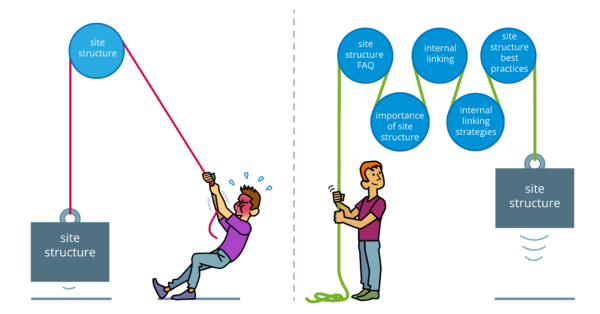Why is Google ranking the wrong page?

Your post is optimized, all your bullets in Yoast SEO are green and still, the post you want to rank with does not rank for that keyword. And yet, another page on your website does show up in the results. But that’s not the one you wanted to rank highest with. Why is Google ranking the wrong page? What can you do to change this? In this post, I’ll explore possible causes for why this is happening. And more importantly, I’ll help you fix it!
Explanations for wrong page ranking
If the wrong page turns up in the Search Engine Result Pages (SERPs), it means that Google thinks that this page is a better fit than the post you want to rank with. So why does Google think that? The most plausible cause for having the ‘wrong’ page show up in the search results is keyword cannibalization. But before we go into that, I have to mention another reason, which has to do with search intent.
A mismatch in search intent
One reason that the wrong page is showing up in the search results, is a mismatch in search intent. It could well be that you’ve written an informative article about a product that you sell, but you also have a product page for this specific product. This makes perfect sense, as these pages are focused on a different search intent. But if Google isn’t able to recognize the intended search, the wrong page could end up in the SERPs.
Read more: Use the SERPs to create intent-based content »
Keyword cannibalization
In most cases, the wrong page showing up is caused by keyword cannibalization. This means that you have more than one post or page on your site that can rank for the same search query. If you have multiple pages and posts about the same topic, perhaps even optimized for similar keywords, Google will get confused. It won’t know which one of your articles to rank highest and this results in your articles competing with each other for a position in the SERPs. You might think this isn’t such a bad thing, but you’re cannibalizing your own content. Which means that both pages end up with a lower position in the results.
How to know which pages are ranking
Not sure which of your pages are ranking for their chosen keywords? No problem — we’ve added a neat integration in the Yoast SEO plugin to help you! Using data from Wincher.com’s rank tracking tools, you can easily find out if your page is ranking for your focus keyword (and related keywords too if you’re using Premium). Find out more about why you should track your keywords and how the Wincher integration in Yoast SEO makes it easy.
Keep reading: Rank tracking: why you should monitor your keywords »
Recognize and fix keyword cannibalization
If you suspect that your site might be suffering from keyword cannibalization, it’s important to research this. Just Google your keyword specifically for your site. I’ll explain how this works by using Yoast.com as an example. By typing in site:yoast.com [specific keyword] on Google, it will give you all the posts and pages it finds and considers on Yoast.com for that specific keyword. If you have many pages competing for that same keyword, you’ll probably be experiencing some keyword cannibalization.
In order to start ranking with the right page in the SERPs, you should solve your keyword cannibalization problem. Although finding and fixing keyword cannibalization requires some serious effort, it will definitely pay off. You already know which page you want to rank with. You know which page is most important to you. Now you just have to make sure that Google knows it too.
Solve wrong page ranking with internal linking
Fixing keyword cannibalization helps you assess similar pages and take action to increase the rankings of the right pages. But that’s not all. In order to solve your problem with the wrong page ranking, you also need to improve your internal linking structure. After all, Google follows links. The way you structure your site, the way you internally link one page to the other, gives Google important clues about which pages are important (and which aren’t). Pages that have a lot of internal links will get more visits from the Google bots. But on pages with little or no internal links the Google bots will come around less often.
Pages that have a lot of internal links pointing towards them are deemed important. While pages with little or no internal links will not appear important (in the eyes of Google). That’s something you can act on! Make sure that the page you want to rank with has the most internal links pointing towards it. That way, you’re showing Google which article is most important with the use of internal linking.
The context of internal links
A great internal linking structure only works if your internal links are in context. They have to make sense. The page you want to rank with should have links from pages that are topically related to that specific page. Adding links from random pages to one of your pages does not work. Google just is too smart for that. And it’s bad user experience for your site users. Your internal linking should make sense so that users want to click on internal links, want to read more or to get more detailed information about a related topic.
Example: creating an internal linking setup
Let’s look at an example of how to set up a great internal linking strategy. Because it makes sense to write multiple articles about topics related to your business. So how do you make sure you’re not cannibalizing your own content? And how do you tell Google which article is the most important one?
Imagine you want to rank with the keyphrase [site structure]. That’s a rather competitive keyphrase. If you’re just starting out in blogging about site structure, it might be hard to rank for that term. A great strategy is to write different articles each focussing on a different aspect of site structure, for example: [site structure FAQ], [internal linking], [site structure best practices]. These search terms are less competitive and these articles will each drive some traffic to your website. However, how do you make sure that Google knows which article is most important?

Your internal linking structure is Google’s guide. You should make sure to put an internal link from each of these articles (site structure FAQ, internal linking, and so on) to that most important one – the ultimate guide to site structure. That way, Google will notice all these different blog posts pointing towards one article. That’ll give Google the information it needs to determine which one it should rank highest in the SERPs, in this case – the ultimate guide to site structure.
Also, it’s important to link to the related (and less important) posts from your ultimate guide. That way, your users will be able to navigate your site easily and Google will better understand the relationship between these articles. So make sure to link both ways.
Read on: More articles on internal linking »
Need help with your internal linking structure?
Setting up an internal linking structure can be rather hard. Especially if you have a lot of articles on your website. How do you find out which could be candidates to link to the article you want to rank with? Yoast SEO premium offers a renewed internal linking feature which helps you set up an awesome internal linking strategy. In this short video, I’ll explain how it works:
In a nutshell, our tool offers suggestions for internal links to similar articles to the one you’re writing. You’ll find the internal linking suggestions in the Yoast site bar while you’re working on your post. Also, cornerstone articles (those articles you most desperately want to rank with) are shown at the top of the list to make sure you don’t forget to link to them.
Conclusion on wrong page ranking
It can be very annoying when Google ranks the wrong page for a certain keyword. In many cases, this can be fixed by improving your internal linking structure. Make sure that other (less important) posts and pages link towards your most important post. That way, Google will know which post is most important to you and will be more likely to reward that with a higher ranking!
Your internal linking structure, your site structure, is like a guide to Google and therefore really important. Luckily, improving this structure is relatively easy and extremely actionable. So, good luck and start ranking with the right post!
Keep on reading: Keyword research: the ultimate guide »
Disclosure: this blog post contains sponsored links.


Discussion (21)